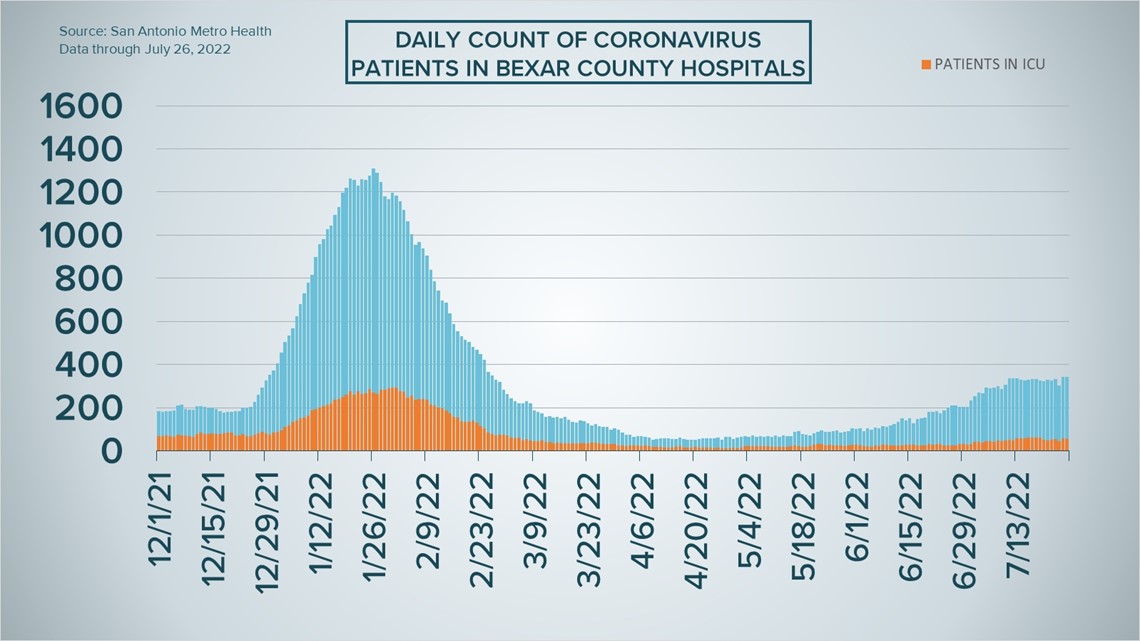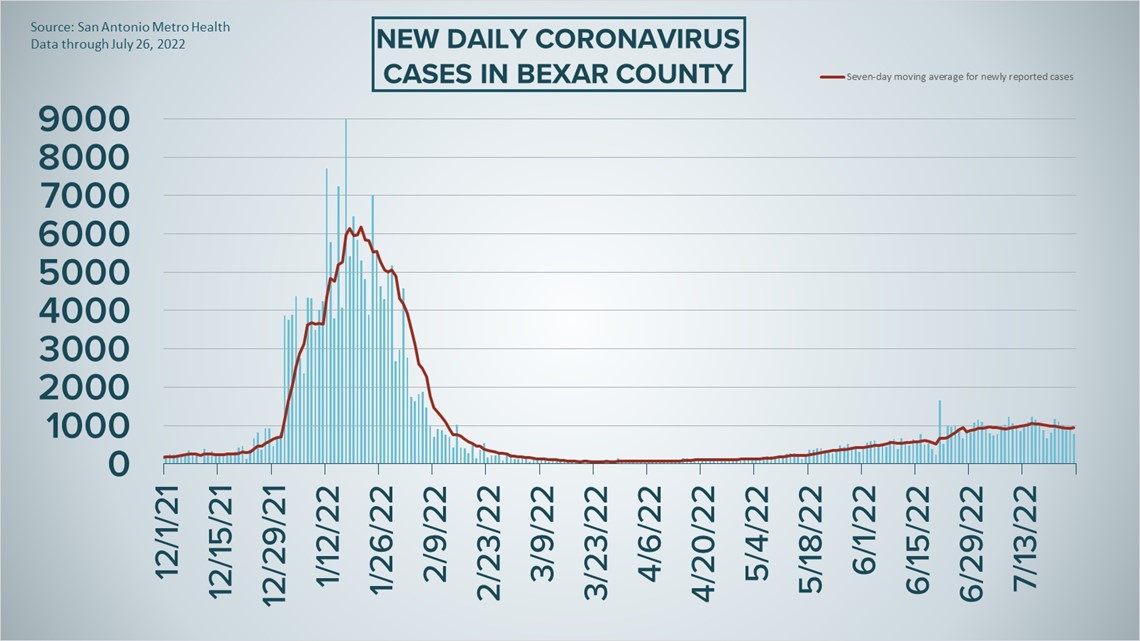SAN ANTONIO — Bexar County health authorities remain on high-alert for coronavirus transmission during a late-summer wave that has yielded 971 new infections a day in July thus far.
That would be the highest daily average for any month since January, when San Antonio was fully in the throes of the omicron surge and averaging more than 4,700 new cases a day. Another 778 cases were reported Tuesday – the lowest total in a week – while the seven-day case average rose slightly to 947 after a recent three-day stretch of at least 1,000 new diagnoses.
Hospitalizations, however, continue to trend up. On Tuesday there were 342 COVID-19 patients receiving treatment in regional hospitals, which is up 4.7% over the last week and an increase of 39% over this time last month. Of those 342 patients, 55 were in intensive care and 14 were using ventilators.
Meanwhile, the march towards 600,000 total Bexar County diagnoses continues. As of Tuesday, at least 597,699 infections have been tallied by Metro Health since the pandemic began.
How Bexar County is trending




Vaccine progress in Bexar County
The following numbers are provided by San Antonio Metro Health. A full breakdown can be found here.
- 1,458,305 eligible Bexar County residents are fully vaccinated as of July 26, which is about 71.7% of the total population. It's 77% of the vaccine-eligible population, since the vaccine is not authorized for children under age 5.
- 555,189 eligible Bexar County residents have received a COVID-19 booster shot as of July 26, which is 39.5% percent of the population.
The CDC states that "when a high percentage of the community is immune to a disease (through vaccination and/or prior illness)," that community will have reached herd immunity, "making the spread of this disease from person to person unlikely."
The City of San Antonio breaks down the vaccination rates by zip code on Metro Health's Vaccination Statistics page.
Coronavirus in Texas
The total number of coronavirus cases in the state grew by 9,571 on Tuesday, according to the Texas Department of State Health Services. That total includes 6,725 new confirmed cases and 2,846 new probable cases. More details can be found on this page.
Tuesday's figures bring the total number of Texans diagnosed with COVID-19 to more than 7.39 million.
An additional 26 Texans have died from virus complications, the state reported Wednesday, raising the statewide death toll to 87,586.
Coronavirus symptoms
The symptoms of coronavirus can be similar to the flu or a bad cold. Symptoms include fever or chills, cough, shortness of breath or difficulty breathing, fatigue, muscle or body aches, headache, new loss of taste or smell sore throat, congestion or runny nose, nausea or vomiting, and diarrhea, according to the Centers for Disease Control.
Most healthy people will have mild symptoms. A study of more than 72,000 patients by the Centers for Disease Control in China showed 80 percent of the cases there were mild.
But infections can cause pneumonia, severe acute respiratory syndrome, kidney failure, and even death, according to the World Health Organization. Older people with underlying health conditions are most at risk.
Experts determined there was consistent evidence these conditions increase a person's risk, regardless of age:
- Chronic kidney disease
- COPD (chronic obstructive pulmonary disease)
- Obesity (BMI of 30 or higher)
- Immunocompromised state (weakened immune system) from solid organ transplant
- Serious heart conditions, such as heart failure, coronary artery disease, or cardiomyopathies
- Sickle cell disease
- Type 2 diabetes
- The CDC believes symptoms may appear anywhere from two to 14 days after being exposed.
Human coronaviruses are usually spread...
- Between people who are in close contact with one another (within about 6 feet).
- Through respiratory droplets produced when an infected person coughs, sneezes or talks. These droplets can land in the mouths or noses of people who are nearby or possibly be inhaled into the lungs.
- Some recent studies have suggested that COVID-19 may be spread by people who are not showing symptoms.
Help stop the spread of coronavirus
- Stay home when you are sick.
- Eat and sleep separately from your family members
- Use different utensils and dishes
- Cover your cough or sneeze with your arm, not your hand.
- If you use a tissue, throw it in the trash.
Find a testing location
City officials recommend getting a COVID-19 test if you experience fever or chills, cough, shortness of breath or difficulty breathing, fatigue, muscle or body aches, headache, new loss of taste or smell, sore throat, congestion or runny nose, nausea or vomiting, or diarrhea.
Here's a Testing Sites Locator to help you find the testing location closest to you in San Antonio.
Latest Coronavirus Headlines
- Biden's COVID symptoms 'almost completely resolved,' White House doctor says
- North Korea pushes traditional medicine to fight COVID-19
- Wear The Gown: COVID booster study for kids
- 'Tremendous amount of COVID': Hospitalizations for the virus are inching up, but data may indicate slowing spread
- WHO: COVID triples across Europe, hospitalizations double
- Study: Student gains last year narrowed COVID learning gap
- CDC endorses more traditional Novavax COVID shot for adults
- Here are the most common symptoms for the BA.5 and BA.4 variants

